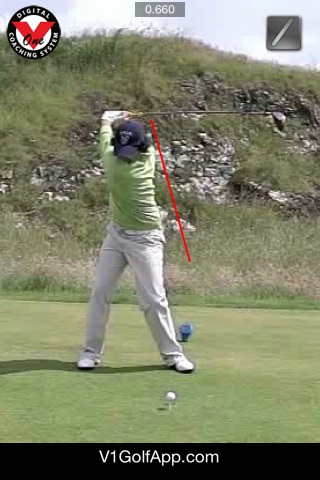
The backswing is a very important part of the golf swing. It truly sets you up in positions that your body can properly unwind into the ball. If done improperly, even if you know the proper downswing, it might be very hard to get down to the ball correctly. Probably the most common error of the amateur golfer in the backswing is the proper amount of turn in the shoulders. A good shoulder turn gives you the necessary time you need to do the things that happen in the down and through swing to hit the ball properly. There is an easy solution to this problem of a poor shoulder turn. I will go over how to make that good turn and explain the positive attributes it will have on your swing if done correctly.
To get the proper shoulder turn, has a very simple solution: Turn your right shoulder back (not your left) and behind you. So many golfers have been told to turn their left shoulder back that their left shoulder might be pointing behind the ball, but the right has stayed were it was. Bio-mechanically your shoulders can squeeze together which is what most amateurs do. I call this a false turn. The way to tell if you have a false turn is look in the mirror or on camera at the top of the backswing and draw an imaginary line from your left shoulder through to your right shoulder; if that line points directional forward of the ball even though your left shoulder is behind the ball laterally, you have not turned far enough. You right shoulder should be turned were it becomes hidden by your neck on a face on view. Basically, both shoulders should be turned ninety degrees from its starting position. The beauty of using your right shoulder to take the club back to the top is that the left will always have to turn the exact same amount. Now I will explain how to turn the right shoulder back properly.
First, when turning your right shoulder back you must keep you right arm away from the direction of your right shoulder turn. What you should feel is the right arm should try to stay extended away from your body only allowing the wrist to set back behind your head. Second, simultaneously turn your right shoulder back behind your right ear on as level of a turn to the ground as possible. This way the shoulders should turn flat to what ever spin angle you have at address (no dipping). By the way, your left shoulder is not pulled under your chin, it comes up to under your chin (level shoulders to spin angle). This relationship of the right arm extending away from the body as the right shoulder is turn back and behind will keep the arms in front of your turn called connection. This will allow you time for the proper sequencing of the downswing. If the arms turn excessively longer then the shoulder turn you often become late with your arms or what is called stuck in your downswing. I do believe in some independent arm action at the top of the backswing so not to become stiff, but it most likely this will happen automatically when you set your wrist at the top. Really commit to the feeling of the right shoulder taking the club away. If you can get this feeling, the club will go back on a better path (on plane) and will truly be swung back rather then pushed back.
I recommend that you practice this move in the mirror first without a ball. You will learn to develop the trust of the right shoulder and right arm combination take away. Also take some one arm, right arm only practices motions to the top of the backswing. Try to keep your right arm extended away from your body with the wrist set. After you have stopped in that position with your right shoulder turned behind you, take your left arm and reach for the club handle. Once you can reach the handle you will feel the appropriate right shoulder turn needed for a proper backswing. You will feel great extension, leverage and the power needed to make the downswing. Once you have felt the shoulder turn and extension, start hitting some balls. You will get used to it very fast. The backswing can only mess you up, so a good turn is a consistency that you will never be able to blame for a poor shot again. Hope you enjoyed the tip and good golfing.
Source
2007 PGA Magizine and PGA Internet magazine
